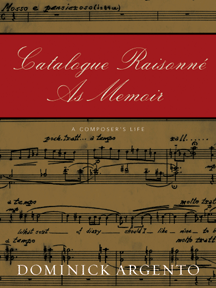A Fine Libretto: A Review of Dominic Argento’s Memoir
Justin Rubin reads Dominic Argento's "Catalogue Raisonne as Memoir: A Composer's Life," published on University of Minnesota Press, and finds it informative--as well as (even better) sparkling, amusing, and fun.

Dominick Argento forewarns his readers in the preface to his Catalogue Raisonné As Memoir: A Composer’s Life, that if they anticipate gaining an understanding of his creative process, compositional secrets, or some elusive key to the success of his music, that they will be left unsatisfied by its conclusion. However, he further admits in these opening pages that these aspects of his music remain a mystery to him as well, that each work finds its own natural path in which he plays more the role of mentoring parent than dictator. He continues, saying that, outside of some factual information, the book will primarily provide his recollection of the circumstances that surround each work of his from concept to performance. Despite all of this, the reader will inevitably find that the means by which Argento’s creative personality finds expression is indeed present, albeit in a different form.
Beginning with the very first work he acknowledges from his student
days, Argento escorts the reader through the rush of his memories as he himself experiences them, transporting us from imagining the bus trips to and from college on weekends, to the personal relationships he had with his teachers spanning decades, to the blind date he had with the young and enthusiastic soprano that would premier this composition and eventually become his wife – all within the first four pages.
Argento speaks of how most of his compositions deal with a character that goes though some form of self-discovery. He states too that his musical works are almost without exception based on an extra-musical narrative. What we soon begin to observe through reading about each successive piece is that this book is simply another extra-musical means by which Argento searches for self-discovery; but here it is his own life through which we are escorted by means of the intensely personal narrative of his experiences.
Even more than his words regarding the actual compositions, the flurry of disjointed, wonderful, and touching stories and events (which range from recalling particular meals after
important performances and meetings, the ambience of a theatre, or the look on the face of a conductor) that attach in his memory to each piece give one something to identify with and vividly imagine. It is as if we are accompanying the composer as he gropes toward an
understanding of the journey he himself has taken through the course of writing his complete oeuvre–which is indeed Argento’s life itself.
Also of interest are the composer’s humorous insights, poetic
descriptions, and opinions of leading American and European musicians with whom he had some dealings, both sympathetic and hostile toward his own aesthetic outlook, including Henry Cowell, Luigi Dallapiccola, Pierre Boulez, and a host of others. These are particularly illuminating, as in a memoir one can candidly reveal much that could not be objectively documented in a musicological tome. Societal and religious issues, such as the use of the vernacular in the Catholic Mass, become part of his discourse and inform the concept behind his sacred works.
An overriding concern that can be read throughout is the general use of language in music, something Argento’s sensibility is
especially attuned to and which he critiques without leniency.
For a Minnesotan, his recollections possess an added impact, as he often makes reference to his numerous colleagues and supporters throughout the state. At one point he remarks how being in Minnesota has made him feel useful and loved by a more localized artistic community that has embraced his work as something simply needed in their lives.
The undertaking of a memoir during, perhaps, the final creative period of any artist’s life can lead the unsuspecting reader astray from the acknowledged view of that artist from an objective and critical perspective. Argento avoids these shortcomings and produces a personally engaging book, carefully balancing emphasis between the varied stages of the his output, covering both well known and obscure works from his first mature period to mid-career successes and current developments, while avoiding vocabulary that is unnecessarily technical. Going far beyond mere program notes to his music, what shines through is his personality, brimming with wit and sensitivity, always in a disarming tone and never more distant than if he was speaking to an intimate friend. As an inimitable composer of American opera, this book may be his finest libretto for the song of his life.